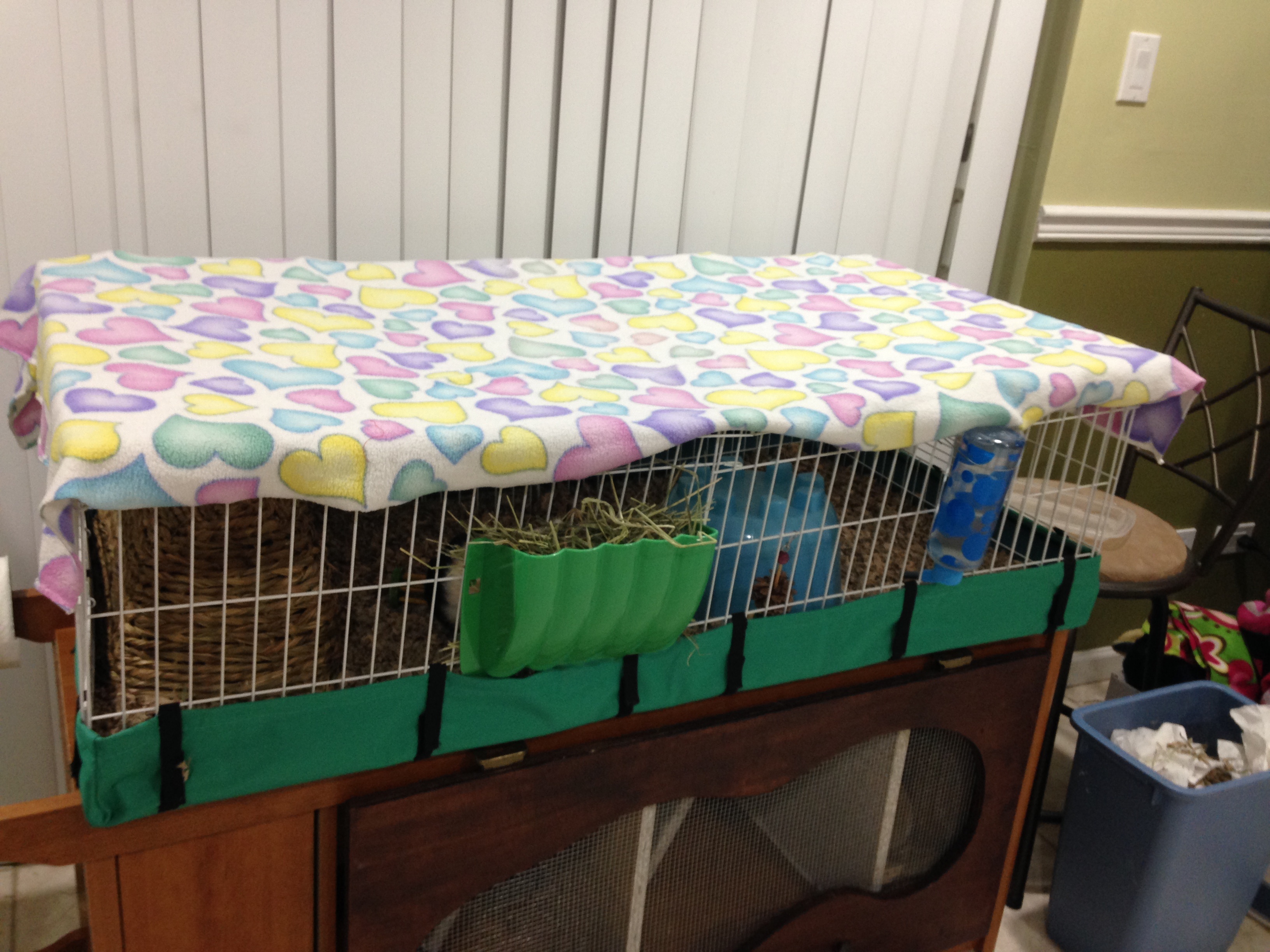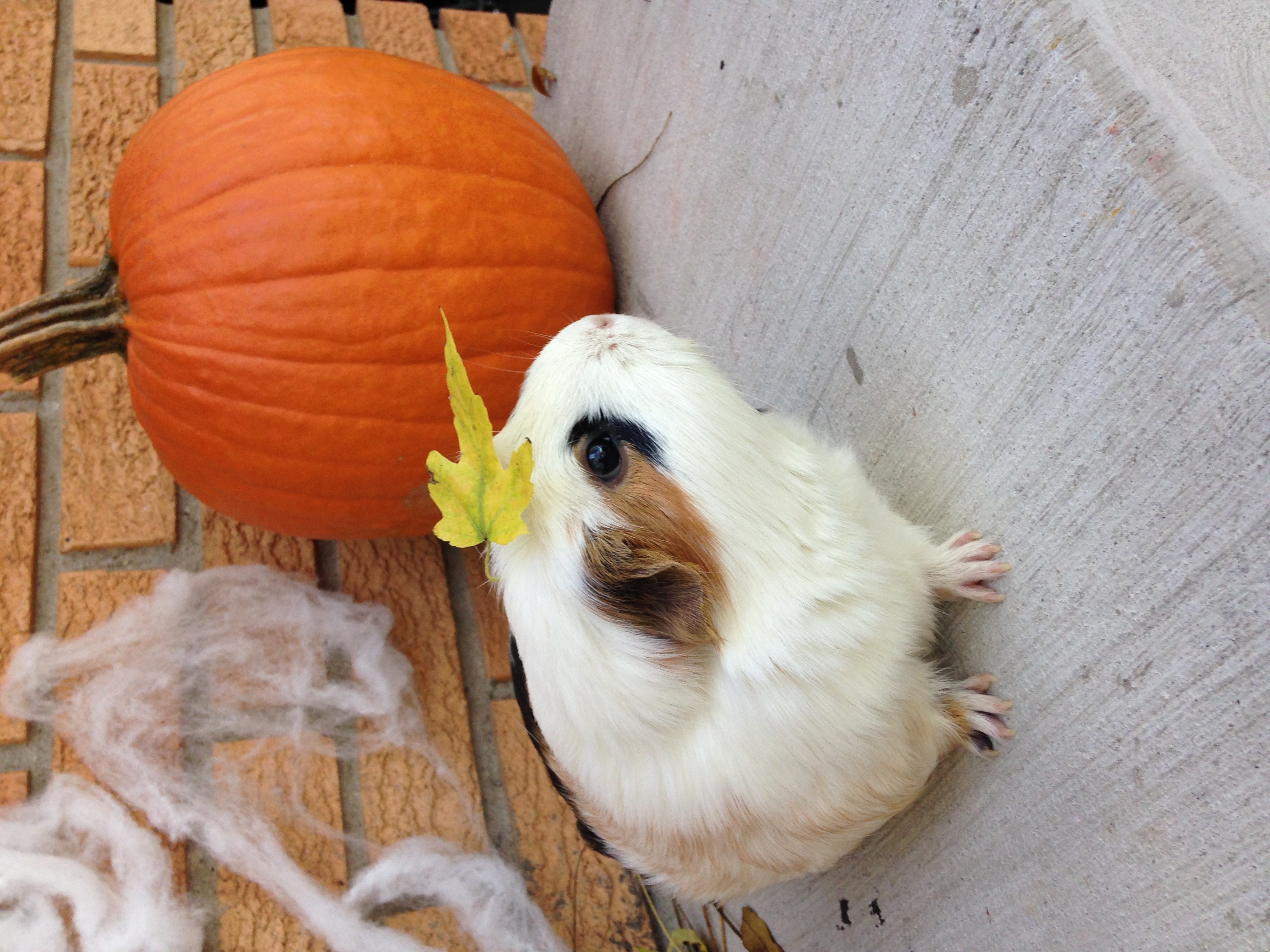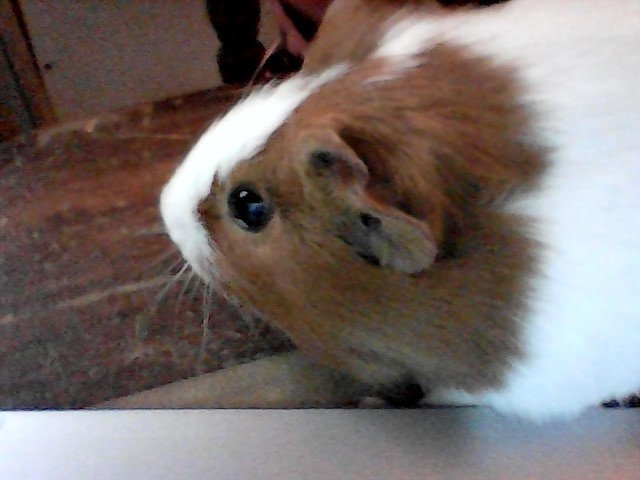 |

Photo courtesy of HappyCavy fan pyza*
Guinea pigs are always eating. Whether it’s pellets, grass hay, daily greens, or the occasional fruit snack, it may often seem like your guinea pig is born to eat (and create magic beans).
With an insatiable diet comes the responsibility to learn what constitutes a proper guinea pig diet. Choosing guinea pig safe foods can be a bit of a challenge. There are so many types of fruits, vegetables, and herbs that guinea pigs can eat.
So what should you be feeding your guinea pig?
What fruits and ? What fruits can guinea pigs eat?? And herbs? What about those?
- What can guinea pigs eat?
- Which vegetables, fruits, and herbs are safe to feed your guinea pig?
- Are the foods you have been giving your cavy “guinea pig safe“?
- Besides water, high-quality hay, and pellets, what else can your guinea pig eat?
→ Jump to the Guinea Pig Safe Food List
First, let’s take a look at the basics of a guinea pig diet or jump to What The Happy Cavy Herd Eats for a general guide on the daily dietary requirements of guinea pigs.
A guinea pig’s diet should consist of the following:
#1. Water

A constant fresh source of fresh (preferably filtered but NOT distilled) clean, room-temperature water is an absolute must.
Water bottles should be emptied, rinsed, and re-filled each day.
#2. Grass Hay
High-quality grass hay (such as timothy hay) should be available at all times for your guinea pig. Hay delivers the fiber that that is essential for your guinea pig to be able to properly digest and proces food and nutrients. Without a constant intake of fresh hay, guinea pigs’ digestive tracks can shut down. Plus, hay helps guinea pigs keep their teeth clean prevents their teeth from growing too long.
How do you know if hay is high-quality? High-quality hay should be green with pliable stalks, free of mold and foreign particulates, and fragrant (not dusty or void of smell). Cheap, store-bought hay is no substitute for fresh, high-quality yummy goodness.
Most hay purchased at “big box” stores (PetCo, etc.) is NOT high-quality hay. Farm-to-cage is ideal and special caution should be taken when providing the most important food of your guinea pig’s diet: high-quality, pesticide(?) free hay.
NOTE: An alfalfa hay mix (1/2 timothy, 1/2 alfalfa) should be primarily fed to young guinea pigs under the age of 4 months and pregnant or nursing cavies. Because alfalfa hay is high in calcium, it should NOT be fed to healthy, adult cavies. Healthy, adult guinea pigs should be fed lower-calcium hays such as timothy hay or orchard grass hay.
#3. Pellets

Provide your guinea pig with about 1/4 – 1/8 cup of plain, corn- and seed-free guinea pig pellets for eating each day. Pellets are less important than a constant supply of fresh grass hay, though pellets can provide additional vitamins and nutrients that your guinea pig isn’t getting from hay alone, especially if the pellets are fortified in Vitamin C.
Guinea pig pellets should consist of only high-quality hay and should be served in a ceramic bowl, which is large enough to not tip over.
NOTE: Pellets alone are NOT a substitute for hay! High-quality grass hay is a must for proper guinea pig health.
Vitamin C
Like Humans, guinea pigs cannot manufacture their own vitamin C. To prevent survy and other health issues, each guinea pig should get 10 to 30 milligrams of Vitamin C each day; young, ill, nursing and/or pregnant animals require extra Vitamin C. While many guinea pigs will get an adequate serving of Vitamin C from vegetables and pellets, you may wish to supplement your cavy’s diet with a small amount of Vitamin C, either in power or tablet form.
NOTE: It is NOT recommended that you use water-soluable drops for supplementing Vitamin C. Watch How to Give Vitamin C to Your Guinea Pig (video) to see how HappyCavies get their Vitamin C.
Vegetables, Herbs, & Other Foods

Guinea should be fed only up to 1 cup (240 mL) each (adults) of vegetables per day. However, it is ideal for you to limit their intake of vegetables. Just because they CAN have up to 1 cup doesn’t mean they need it. Please remember that your guinea pig’s food supply should NOT be mainly vegetables. And watch their calcium intake! Foods high in calcium can lead to the formation of bladder stones and other health issues.
To help you find which vegetables, herbs, and fruits are safe to feed your guinea pig, please refer to the Guinea Pig Food List below.
NOTE: Always introduce new foods to your guinea pig slowly and patiently. Begin introducing new foods by providing a small piece or two during the “first try”. Then, portions of a particular guinea pig safe food may be increased slightly with each subsequent serving. The way that you introduce nutrients is as important as a healthy diet. Guinea pigs have a sensitive digestive system which is easily upset.
Help Us Maintain The Food List!
There are so many foods a guinea pig can eat. If you know of a food that is not included in this list which you think we should add, please let us know!
Share This Guinea Pig Nutrition & Diet Info
Then Like and Plus →
Guinea Pig “Safe Food List”
Updated: February 14, 2024
Click a letter to view that vegetable and refer to the “Notes” for cautionary advice.
Information on this chart is derived from the USDA FoodData Central. Information may have changed since the publication of this chart.
This chart takes into consideration several factors to arrive at our feeding frequency suggestions: sugar, calcium, phosphorous, Vitamin C, Vitamin A, oxalic acid content, and calcium to phosphorous (Ca:P) ratio. Not all fields are displayed due to space requirements. Chemical composition can be referenced at the USDA FoodData Central.
IMPORTANT: There are other important nutritional factors not represented in this chart. Please use GuineaLynx’s Vegetable/Fruit resource for additional information such as Calcium/Phosphorus Ratios and Oxalic Acid information: http://www.guinealynx.info/diet_ratio.html
CHART KEY
Almost daily
Frequently: 2-4 times per week
Occasionally: 1-2 times per week
Rarely: 1-2 times per month
DO NOT copy or distribute this list it without express permission from HappyCavy.com. Contact us if you wish to use this list on your website.
| A | B | C | D | E | F | G | H | I | J | K | L | M |
| N | O | P | Q | R | S | T | U | V | W | X | Y | Z |
Recommended Feeding Frequency:
Almost daily
Frequently: 2-4 times per week
Occasionally: 1-2 times per week
Rarely: 1-2 times per month
| VEGETABLE / FRUIT (fresh & raw) |
VITAMIN C in mg (per 100g) |
CALCIUM in mg (per 100g) |
Notes |
| Alfalfa – pellets | 0 | 2200 | Alfalfa pellets are suitable for young, growing and/or pregnant guinea pigs (under 1 year of age). Ref. Pellets: Alfalfa vs Timothy. |
| Apple | 4.60 | 6.00 | Apple seeds are poisonous |
| Apricot | 10.00 | 13.00 | |
| Arugula lettuce | 15.00 | 160.00 | |
| Asparagus | 17.69 | 28.14 | May cause gas or bloating. |
| Banana | 9.10 | 6.00 | Can cause constipation. |
| Basil | 4.5 | 38.0 | Can cause constipation. |
| Beet greens/leaves (beetroot greens/leaves) |
30.00 | 117.00 | |
| Beets (beetroot) | 4.90 | 16.00 | |
| Bell pepper | See Peppers (capscium) | ||
| Blackberries | 21.00 | 32.00 | |
| Blueberries | 9.7 | 6.00 | Feed in moderation. |
| Broccoli raab, rabe, rapini | 93.00 | 48.00 | May cause gas or bloating. |
| Broccolini | 93.00 | 48.00 | Stems are liked better than flowers |
| Brussels sprouts | 85.00 | 42.00 | May cause gas or bloating. |
| Cabbage, green | 51.00 | 47.00 | May cause gas or bloating. |
| Cabbage, red | 57.00 | 51.00 | May cause gas or bloating. |
| Cabbage, Chinese pak-choi | 45.00 | 74.00 | May cause gas or bloating. |
| Cabbage, Savoy | 31.00 | 35.00 | Feed in moderation. May cause gas or bloating. |
| Cantaloupe (rock melon) | — | — | See Melon – Cantaloupe (rock melon) |
| Carrots | 5.9 | 33.00 | High Vitamin A. Feed in moderation. |
| Carrots, baby | 2.60 | 32.00 | High Vitamin A. Feed in moderation. |
| Carrots, top greens | unknown | unknown | Unknown nutrient makeup. Feed sparingly. |
| Cauliflower / Broccoflower | 46.40 | 22.00 | |
| Celery | 7.00 | 40.00 | Choking hazard. Remove the celery “veins” to prevent hazard. |
| Cherimoya | 9.00 | 23.00 | Very in very small amounts. |
| Cherries (without pits) – sour | 10.00 | 16.00 | |
| Cherries (without pits) – sweet | 7.00 | 13.00 | |
| Chicory, greens | 24.00 | 100.00 | |
| Chicory, witloof | 2.80 | 19.00 | |
| **Cilantro (corriander) | 27.00 | 67.00 | Feed in moderation. |
| **Collards | 35.30 | 145.00 | May cause gas or bloating. |
| Corn on the cob (1 med ear) | 6.10 | 2.00 | May cause gas or bloating. |
| Cranberries | 13.50 | 7.00 | Feed in moderation. |
| Cress, garden | 69.00 | 81.00 | |
| Cucumber with peel | 5.30 | 14.00 | |
| Dandelion Greens | 35.00 | 187.00 | |
| Dill | 85.00 | 208.00 | |
| Eggplant | 6.5 | 6.5 | |
| Elderberries | 36.00 | 38.00 | Feed in small amounts. |
| Endive (escarole) | 6.50 | 52.00 | |
| Fennel, fronds & leaves | not recorded specially for fronds & leaves | not recorded specially for fronds & leaves | Feed rarely. |
| Grapefruit, white | 37.00 | 15.00 | Sour foods can cause mouth sores. |
| Grapes | 4.00 | 14.00 | |
| Grass (lawn) | — | — | See Hay |
| Green beans, snap | 12.20 | 37.00 | |
| Hay | varies by type | varies by type | IMPORTANT: Read Selecting Hay. |
| Honeydew | 120.00 | 135.00 | See Melon – honeydew |
| Kale | 120.00 | 135.00 | |
| Kiwifruit, fuzzy (kiwi or kiwi fruit) | 92.70 | 34.00 | Remove brown, fuzzy skin. |
| Kohlrabi | 62.00 | 24.00 | Feed in moderation. |
| Kumquat | 37.40 | 44.00 | |
| Lavender | 12.00 | 215.00 | |
| Lettuce – butterhead, boston, bibb |
3.70 | 35.00 | |
| Lettuce – romaine (cos lettuce) |
4.00 | 33.00 | |
| Lettuce – red leaf |
3.70 | 33.00 | |
| Mammy-apple (mamey) | 14.00 | 11.00 | |
| Mandarin orange (or tangerine) | 30.80 | 14.00 | Feed in small amounts. |
| Mango | 27.70 | 10.00 | |
| Melon – Cantaloupe (rock melon) | 36.70 | 9.00 | Feed in small amounts. |
| Melon – casaba | 16.00 | 5.00 | |
| Melon – honeydew | 24.80 | 6.00 | |
| Melon – watermelon | 9.60 | 8.00 | |
| Mint (peppermint) | 31.80 | 243.00 | |
| Mustard greens | 70.00 | 103.00 | May cause gas or bloating. |
| Nectarine | 5.40 | 5.00 | |
| **Okra | 21.10 | 81.00 | |
| Orange | 53.20 | 40.00 | Citrus can cause mouth sores. |
| Oregano | 2.30 | 1597.00 | Feed in very small amounts. |
| Papaya | 61.80 | 24.00 | |
| **Parsley (curly or flat) | 133.00 | 138.00 | |
| Parsnip | 17.00 | 36.00 | |
| Passionfruit, purple | 30.00 | 12.00 | |
| Peach | 6.60 | 5.00 | |
| Peas, edible-podded | 40.00 | 25.00 | |
| Pears – Asian | 3.80 | 4.00 | |
| Pears – European | 6.60 | 18.15 | |
| Peppermint | 31.8 | 243.00 | |
| Peppers (capscium), sweet green | 80.40 | 10.00 | May cause gas or bloating. |
| Peppers (capscium), sweet orange | 146.7 | 0.00 | May cause gas or bloating. |
| Peppers (capscium), sweet red | 127.70 | 7.00 | May cause gas or bloating. |
| Peppers (capscium), sweet yellow | 183.50 | 11.00 | May cause gas or bloating. |
| Persimmon | 66.00 | 27.00 | Feed in very small amounts. |
| Pineapple | 15.40 | 7.00 | Citrus can cause mouth sores. |
| Plum | 9.50 | 4.00 | |
| Pumpkin | 11.00 | 39.00 | High in Vitamin A. |
| Pumpkin Leaves | 11.00 | 39.00 | High in Vitamin A. |
| Quince | 15.00 | 11.00 | |
| Radicchio | 8.00 | 19.00 | |
| Radishes | 14.80 | 25.00 | |
| Raspberries | 26.00 | 25.00 | |
| Raspberry leaves (from raspberry plant) | 25.00 | 22.00 | |
| Spearmint | 13.3 | 199.00 | Feed in very small amounts |
| **Spinach | 28.10 | 99.00 | May cause gas or bloating. Contains high levels of oxalic acid. |
| Squash, summer | 17.00 | 15.00 | |
| Squash, winter | 12.30 | 28.00 | |
| Starfruit | 34.40 | 3.00 | |
| Strawberries | 56.70 | 14.00 | Feed in moderation. |
| Sweet potato | 22.70 | 22.00 | |
| Sweet potato leaves | 11.00 | 37.00 | |
| **Swiss Chard | 30.00 | 51.00 | Feed in moderation. May cause diarrhea. |
| Taro leaves | 52.00 | 107.00 | |
| Thyme | 160.01 | 405.00 | Feed in moderation. |
| #Tomato, red, cherry tomatoes | 19.10 | 5.00 | Avoid leaves and stems (poisonous) – See Dangerous Food List |
| Turnip greens | 60.00 | 190.00 | |
| Watercress | 43.00 | 120.00 | |
| Watermelon | — | — | See Melon – watermelon |
| Watermelon rind | — | — | Vitamin & mineral content unknown. Watermelon rind is safe. |
| Wheatgrass | ~4.00 | ~28.00 | Fresh grasses may cause gut upsets. |
| Zucchini (courgette) | 28.00 | 1.00 |
# Vitamin C values for tomatoes differ depending on variety and season.
** Contains oxalic acid which may contribute to the formation of bladder stones.
Please email hello[at]happycavy.com to make additions to this list.









Why on earth do you have leek in your safe food list, since Leeks are part of the onion and garlic family and are not good for guinea pigs. This food list seriously needs to be updated. No Leeks, and my girls disagree with you they love carrot greens 🙂
Hello, I am 6 1/2 years old. I made this recipe for my Guinea pigs and they LOVED it! I call it Guinea Pig Mush. First, you get guinea pig lettuce out of the fridge if you have any guinea pigs – and wash the lettuce. Then, you get a container out, and you put the lettuce in the container. and then you put water in it so the guinea pigs can drink it. Then, you put it on the counter in the kitchen and take a fork, knife, and spoon : cut, smash, and poke at the lettuce to make the guinea pig mush. Then you transfer it into a little bowl with the water and place it inside their cage (in a place that it will be secure and not spill over). They LOVE it ! Bye !!!
My piggie loves veggies she’s so spoiled and she just got a new cage

What a pretty cage for such a pretty girl!
Can guineas eat the green part of the peanut plants?
No, they cannot.
Does it matter the type of bell pepper? (Green, red, orange, yellow)
Grass is not a good substitute for hay. It can be Ann addition, fresh in the summer, bit she will still need hay. Lone eats a ton of it daily.
I know this page is old, but I have recently adopted two piggie brothers. My older one, Phantom, is more skittish than the other and runs away form me. The younger one. Caffeen, is more tolerant. I’ve been feeding them various veggies including cucumbers, lettuce (not iceburg), and tomatoes. My guinea pig, Phantom, prefers tomatoes, whilst Caffeen, prefers cucumbers. They both will happily eat. My question is– do you have any guinea pig food recipes? I’m doing lots of research and I’m even writing a book about guinea pigs (maybe, I’m most likely not going to publish it). If you have any good recipes, please let me know. Thanks! Here’s a picture of Caffeen (I couldn’t manage to catch Phantom :c)

Also, do you know how to help them be less skittish? Thanks again!